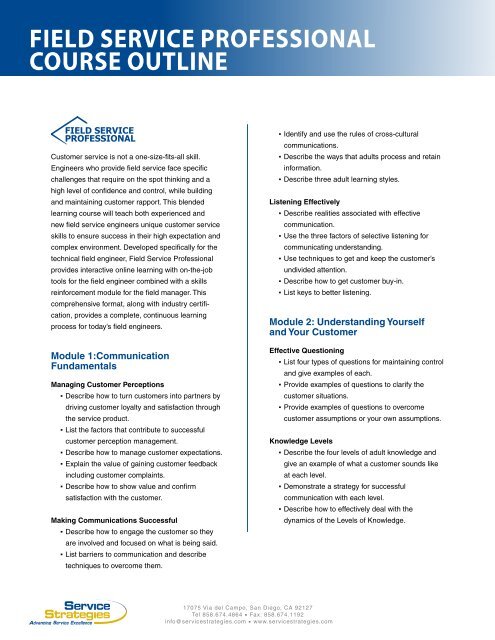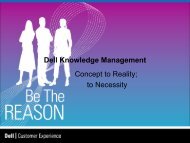field service professional course outline - Service Strategies
field service professional course outline - Service Strategies
field service professional course outline - Service Strategies
You also want an ePaper? Increase the reach of your titles
YUMPU automatically turns print PDFs into web optimized ePapers that Google loves.
Field <strong>Service</strong> ProfessionalCourse <strong>outline</strong>FIELD SERVICEPROFESSIONALCustomer <strong>service</strong> is not a one-size-fits-all skill.Engineers who provide <strong>field</strong> <strong>service</strong> face specificchallenges that require on the spot thinking and ahigh level of confidence and control, while buildingand maintaining customer rapport. This blendedlearning <strong>course</strong> will teach both experienced andnew <strong>field</strong> <strong>service</strong> engineers unique customer <strong>service</strong>skills to ensure success in their high expectation andcomplex environment. Developed specifically for thetechnical <strong>field</strong> engineer, Field <strong>Service</strong> Professionalprovides interactive online learning with on-the-jobtools for the <strong>field</strong> engineer combined with a skillsreinforcement module for the <strong>field</strong> manager. Thiscomprehensive format, along with industry certification,provides a complete, continuous learningprocess for today’s <strong>field</strong> engineers.Module 1:CommunicationFundamentalsManaging Customer Perceptions▪ Describe how to turn customers into partners bydriving customer loyalty and satisfaction throughthe <strong>service</strong> product.▪ List the factors that contribute to successfulcustomer perception management.▪ Describe how to manage customer expectations.▪ Explain the value of gaining customer feedbackincluding customer complaints.▪ Describe how to show value and confirmsatisfaction with the customer.Making Communications Successful▪ Describe how to engage the customer so theyare involved and focused on what is being said.▪ List barriers to communication and describetechniques to overcome them.▪ Identify and use the rules of cross-culturalcommunications.▪ Describe the ways that adults process and retaininformation.▪ Describe three adult learning styles.Listening Effectively▪ Describe realities associated with effectivecommunication.▪ Use the three factors of selective listening forcommunicating understanding.▪ Use techniques to get and keep the customer’sundivided attention.▪ Describe how to get customer buy-in.▪ List keys to better listening.Module 2: Understanding Yourselfand Your CustomerEffective Questioning▪ List four types of questions for maintaining controland give examples of each.▪ Provide examples of questions to clarify thecustomer situations.▪ Provide examples of questions to overcomecustomer assumptions or your own assumptions.Knowledge Levels▪ Describe the four levels of adult knowledge andgive an example of what a customer sounds likeat each level.▪ Demonstrate a strategy for successfulcommunication with each level.▪ Describe how to effectively deal with thedynamics of the Levels of Knowledge.17075 Via del Campo, San Diego, CA 92127Tel 858.674.4864 ▪ Fax: 858.674.1192info@<strong>service</strong>strategies.com ▪ www.<strong>service</strong>strategies.com
Communication Preferences▪ Assess your own energy profile.▪ Identify and describe four different personal energy profiles.▪ Identify stressors associated with each energy type.▪ Describe how to deal with personality conflict with team members and customers.<strong>Service</strong> Above and Beyond▪ Understand the “<strong>service</strong>” product▪ Describe how to turn complaints into additional <strong>service</strong> opportunities.▪ Match company <strong>service</strong>s and products to customer needs.▪ Professionally offer identified <strong>service</strong>s and products.Module 3: Communication MethodsFace-to-Face Communications▪ Explain the importance of <strong>professional</strong> appearance.▪ Read body language cues to determine the real message.▪ Prepare and deliver <strong>professional</strong> presentations on products or project status.▪ Respond with control to hostile questions from the audience when presenting.Telephone Communications▪ Explain the importance of presenting a positive image.▪ Describe how to make your customers feel important▪ Describe techniques for communications power.▪ Identify the steps for putting a caller on hold and transferring a call.Electronic Communications▪ Name at least three rules of protocol for electronic communications.▪ Describe <strong>professional</strong>ism as it relates to electronic communication.▪ Write an example of each of the five elements of clear writing.Module 4: Challenging CustomersManaging Challenging Situations▪ List the three steps to effectively say “no” to a customer.▪ Apply the three steps to deliver negative news, including increased scope of work.▪ Name the steps to properly prepare for escalation.▪ Use specific phrases and techniques to overcome customer objections.Basic Steps in Negotiating▪ List the rules of negotiation.▪ Use questions and statements to drive information gathering and cooperation.▪ Follow the sequence of steps for negotiation success.17075 Via del Campo, San Diego, CA 92127Tel 858.674.4864 ▪ Fax: 858.674.1192info@<strong>service</strong>strategies.com ▪ www.<strong>service</strong>strategies.com
▪ Recognize and apply strategies to typical tactics used by customers to influencethe outcome.Working with Difficult Customers▪ Name the four stages of conflict.▪ Apply communication strategies to neutralize conflict and prevent escalation.▪ Identify the seven types of challenging customers.▪ Describe two techniques to employ in dealing with each type.▪ Follow a series of steps to calm an angry customer.Module 5: Maintaining Confidence & Credibility / EffectiveTeamworkMaintaining Confidence & Credibility▪ Examine your own level of confidence and how it affects job performance.▪ Name at least two techniques for answering questions confidently.▪ Use positive words and phrases to create confidence.▪ Name at least three topics to avoid with the customer to protect company credibility.▪ Respond to challenging questions by telling the truth while protecting companycredibility.Effective Teamwork▪ Compare advantages, disadvantages, and challenges of teamwork.▪ Use both analytical and interpersonal behaviors in working with teams.▪ Describe requirements of an effective team leader and team member.▪ Determine your teamwork profile and how it affects your role as a team member.Module 6: Basic Organization and ProductivityStress Management▪ Name specific signs of stress that affect your ability to work effectively.▪ Identify events that cause you stress on the job.▪ Create stress relievers to prevent stress from becoming burnout.▪ Break barriers that prevent you from taking control of stressful situations.Time Management▪ Choose actions to accept, avoid, alter, or adapt to stressors.▪ Write goals in SMART format.▪ List daily tasks and categorize to become proactive in decision-making.▪ Use FIRR technique to communicate which tasks to focus on.▪ Rely on team and strategies to stay on track.17075 Via del Campo, San Diego, CA 92127Tel 858.674.4864 ▪ Fax: 858.674.1192info@<strong>service</strong>strategies.com ▪ www.<strong>service</strong>strategies.com








